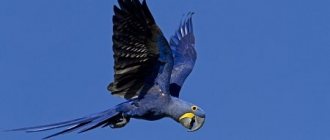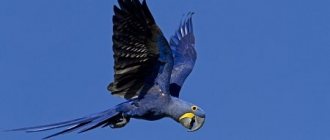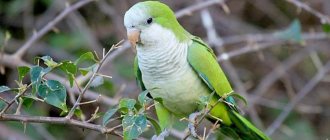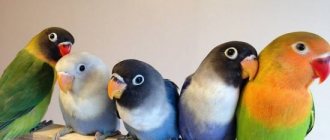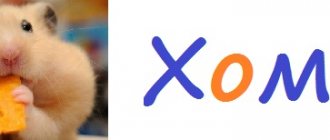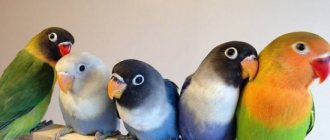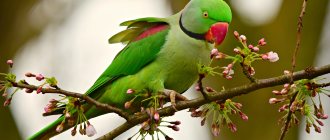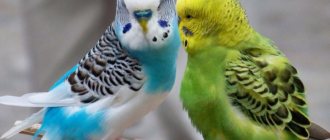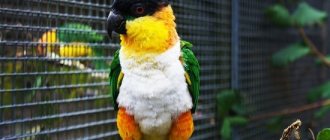Description and features
Parrots are birds that cannot be confused with anyone else. They arouse universal sympathy and interest. Firstly, because these creatures are exotic and extremely beautiful. Secondly, they are famous for their rare ability to reproduce a wide variety of sounds and even repeat human speech.
Most of these bird species have existed on earth without change for many millennia. These birds were kept in ancient temples, considering them sacred. They became the favorite pets of many noble and famous people, starting with Alexander the Great, at whose court the original talkative birds, brought from distant countries, first appeared in Europe.
In addition to those already listed, parrots are naturally endowed with many unique features. First of all, the structure of their beak is unusual, which actually serves as the third paw of such birds. In the wild, living in trees and climbing them, they dexterously grab onto branches with a similar hooked device.
Parts of a parrot's beak are very mobile. The lower one is able to mix in all directions, and independently of it the upper one can rise and fall. Special scars at the end of the beak, resembling a file, enable these birds to carefully grind the fruits on which they feed. Such birds are able to bite through even a nut shell. And their tongue, which has a depression at the end, helps parrots grab seeds.
These creatures are widely known for their amazing colors. Their feather outfits can be of the most incredible, bright, original colors and consist of combinations of many shades. But the subject of our description will be blue parrots .
Keeping budgies at home
The bird cage should be installed on a hill (somewhere at human eye level) in a place where there is enough sunlight. In such conditions, parrots will feel very comfortable. It is very important that long daylight hours are organized for birds, lasting at least 14 hours in summer and at least 12 hours in winter. With the arrival of autumn, you should start turning on additional lighting. You should never place a parrot's cage on a windowsill, as they may catch a cold.
Cage structure
To keep one parrot you will need a cage with dimensions of 40x40x25 centimeters. Therefore, it is not difficult to calculate how much space will be needed to contain 2, 3, etc. birds.
Experts indicate that a rectangular cage is better because it is much easier to attach toys to its top.
It is desirable that the bottom of the cage is solid, then the bird’s claws will not get stuck in the spaces between the bars.
The arrangement of the cell may include a whole set of useful components, such as:
- A couple of perches, maybe more.
- Glass or porcelain drinkers.
- Pairs of feeders to feed your parrot different foods.
- Baths with warm water.
- There should be a mirror on the ceiling if there is only one parrot.
Excessive objects in a parrot's home are unacceptable, since dust accumulates on them.
Important point! Before use, the purchased cage with accessories must be sterilized by dousing them with boiling water and wiping them dry.
Rules of care and maintenance
A change of place of residence for parrots does not pass without leaving a trace, so they need rest for the first two or three weeks. To do this, it is necessary to take all measures to ensure that peace is maintained in the house and no loud sounds are heard. During this period, it is advisable to protect the bird from the attention of children and pets. You need to talk to the parrot affectionately, but not pick it up until the bird itself decides to do so.
At night, it is advisable to cover the cage with a cloth, leaving the front part free. In such conditions, the parrot will calm down faster and stop making sounds, maintaining complete silence during the rest period.
With the arrival of spring warmth, it is necessary to take the cage with the parrot out onto the balcony, but not into open sunlight. Under the influence of the sun, the parrot's body begins to produce vitamin D, which is very important for the pet's health.
Budgerigars molt twice a year and do not fly during this period. During this period, it is better not to disturb the bird by feeding it with vitamins.
Access to water should be free, although parrots do not drink that often. There is no need to boil the water, but you need to pass it through a filter, sometimes adding a couple of drops of lemon juice. It is better not to use tap water, but to buy clean bottled water.
The perches should only be made of wood, otherwise the parrots’ claws will not grind down naturally.
Every day it is necessary to carry out preventive cleaning in the cage, and once a month - general cleaning. For prevention, you can use a decoction of chamomile or wormwood.
Diet
The bird is not large and does not require much energy. For her diet, ready-made factory feed is suitable, which includes oats, millet, canary grass, meadow grasses and sunflower seeds. Particular attention should be paid to ensuring that the mixtures are fresh and do not contain dyes or other chemicals.
From time to time you need to give sprouted oats. For this purpose Art. a spoonful of oats is poured with boiling water, and after a couple of hours it is filtered. The remains of such food should be removed immediately, as they quickly spoil.
In order for a pet to please others for a long time, its diet will have to be expanded. For example:
- They feed their pet apples, pumpkins, plums, pears, mangoes, kiwis, strawberries, peaches, and grated vegetables.
- Lettuce leaves, dandelion, dill and spinach, and in winter - ground dry nettle.
- Washed branches of willow and fruit trees.
- Chopped cottage cheese and boiled eggs, as well as grated carrots and beets.
- Honey crackers and sticks for parrots, but in moderation, since the bird risks gaining excess weight.
It is necessary to give your pet fresh food every day. When pouring grain or seeds, the bowl needs to be rid of flakes from yesterday's portion. It is permissible to add vitamins to the diet only during molting, in case of severe stress, during illness, and also when feeding chicks.
It is not recommended to give your pet parrot:
- Raw potatoes and rhubarb.
- Alcohol and chocolate.
- Milk.
Important point! If indoor plants are grown in an apartment, the parrot can easily be poisoned by them. Dangerous plants include delphinium, diefenbachia, snowdrops, oleander, spurge, azalea, daffodils, amoralis bulbs, lily of the valley and asparagus berries.
In order for the bird to undergo normal digestion processes, sand is needed, which can be bought at a pet store. They simply take it and pour it onto the bottom of the cage.
Budgerigar - care and maintenance. How to care for budgies?
How long do budgies live?
In natural conditions, only a few individuals live up to 8 years, but mostly parrots live 4 years or a little more. As a rule, most of them die from cold and hunger and from other natural disasters, including from predators.
It should be noted that, being in artificial conditions, the life expectancy of budgerigars is 2 times longer, and some individuals live up to 20 years.
Diseases and their prevention
Budgerigars suffer from a number of diseases, such as:
- A cold occurs when the bird sneezes or has a runny nose.
- The appearance of ticks and lice beetles.
- The appearance of internal parasites.
- Oviposition is delayed (in females).
It should be remembered that the female can lay eggs, even if she is on her own, without a male. Often the egg does not pass through and gets stuck, which can cause the death of the female. To prevent this from happening, she needs help. To do this, you need to take Vaseline oil and drop a little into the place where the egg is stuck. After this, a warm cloth is placed on the bottom of the cage, and a heating pad under it. If this does not help the bird, then you need to immediately go to a specialist.
By instilling special preparations into the beak, they get rid of some types of parasites. Frontline spray helps against down-eaters; it is applied to the back of the head (under the feathers) so that the parrot cannot reach this place with its beak.
It is important to know! Ointments such as novertin or oversectin will help get rid of ticks. Using a brush, ointments are applied to the beak, wax, paws and in the cloaca area. You can also use vegetable oil.
Parrots with a cold are irradiated several times a day with a table lamp with a light bulb of no more than 60 W, and are also given vitamins. There should be a chamomile decoction at the bottom of the cage.
Parrot breeding
Budgerigars become adults by the age of one and a half years. During the breeding season, you should consider ensuring that the couple has enough light and warmth, eats well and takes vitamins.
For the breeding process, birds should be provided with a nest box with the following requirements:
- The height of the box is no more than 15 cm, width – 15 cm and length 25 cm.
- The box should have a folding top so that you can monitor the condition of the chicks and its cleanliness.
- There should be wood shavings at the bottom.
- There should be a depression where the eggs lie.
- So that the chicks and the female can climb up and down into the nest, something like a ladder should be made.
Chick food should include calcium powder. The food is simply poured onto the bottom of the box.
When the chicks begin to feed on their own, they should be immediately separated from the female so that she does not bite them. The shells and any surviving chicks must be removed immediately. It is not necessary to allow the female to lay eggs more than 2 times in a row, as this leads to her exhaustion. To do this, you just need to pick up and remove the nest box.
HOW TO BREED BUDGETS HOW TO SELECT A PAIR NUMBER BUDGETS CHICKS
Kinds
More than three hundred species of parrots are known. In addition to the parrot family, there are also cockatoos. The latter are distinguished by beautiful crests, a bucket-shaped beak and the absence of green flowers in color. In the wild, parrots inhabit hot latitudes, that is, territories located mainly not far from the equator.
They are found in southern Asia, Africa, Latin America and Australia. In regions with less warm climates there are only domestic specimens of these birds. The blue parrot is not a representative of any specific species. This is just an external sign indicating the predominance of a certain color in the plumage. Let us describe the varieties, among which there are representatives with similar colors.
1. The hyacinth macaw is unique for its stunning size, because these birds can grow up to a meter in length, while weighing approximately one and a half kilograms. The color of their feathers is predominantly blue, but in different shades: it can be grayish or saturated, representing a complex range of blue, violet and, of course, blue.
In most cases, these creatures have a dark beak and gray clawed feet. Their characteristic feature is the absence of plumage around the eyes and under the beak; these areas stand out on the front part as bright yellow.
These parrots are residents of South America and live in forests near freshwater bodies. The character of the giant macaws is very unusual, and many very interesting features are observed in their behavior. But they will be discussed later.
2. Blue and yellow macaw parrot . The upper part of the feathers of such creatures, as well as the tail coverts, are blue or bright blue. Their belly, neck, chest and sides of the neck are yellow with an orange tint. The frontal part is green. All species of macaw, without exception, are famous for their shrill, strong voice, which in the jungle carries over a distance of more than one and a half kilometers from the location of the noisy bird.
3. The budgie has a variety of interesting colors, including blue. This is a mutation breed, often referred to as a cobalt. But the color of its representatives is still not monochromatic. The lower back, crop, belly and long tail feathers are dark blue.
It’s as if a white mask with an original wavy-striped pattern, complemented by black spots and deep purple drops along the edges, is put on the head of such birds. Hence the name of such parrots. They are no more than two tens of centimeters tall, and their homeland is distant Australia. There is also a blue variety of such birds with a very delicate, pleasant color.
4. Masked lovebird. These parrots are on average about 15 cm long. They are ideal pets: friendly, active, and inquisitive. And they got their name for their touching devotion to their partner. The masked variety can also be blue with bluish tints, as well as sea-green areas.
The head of representatives of this species is also hidden by a mask, and the white frame of the black eyes only enhances the resemblance, reminiscent of eye cutouts. The beak of the birds is whitish-pinkish, the abdomen is white. These are inhabitants of Africa, they also live in Madagascar.
5. The Amboin parrot is a feathered creature from the Pacific Islands. This parrot is red and blue with green wings underneath. These beautiful birds from the genus of king parrots are about 37 cm in size. They live in forests, are very active, climb trees with extraordinary dexterity, and fly beautifully.
6. Necklace parrot. Such creatures are found naturally on the African continent and in hot areas of Asia, inhabiting tropical forests. Representatives of this species were considered incredibly valuable in ancient Rome. They were looked after by many servants, and they lived in expensive cages carved from ivory.
In addition to blue, such parrots may have a blue or light green tint of feathers, but their head is distinguished by a blue tint, and an orange edging is clearly visible around the eyes. The necklace variety got its name because of the dark stripe framing the neck of its representatives, which resembles a necklace.
Unusual colors
Bird lovers are very interested in birds with outstanding colors. Among the birds with unusual colors there are budgerigars, which look very impressive. Every active breeder dreams of getting one of these handsome dogs.
Rainbow
Delightfully beautiful, rare bird of the blue series. Blue body shade, light gray flight feathers, yellow mask and blurred opaline pattern. Iridescence is not a mutation, but a special combination of plumage and wavy pattern.
To make a rainbow parrot, three conditions are necessary:
- yellowface;
- opaline;
- whitewing.
The gray factor is not suitable for developing a rainbow combination; purple is more appropriate here. Only it gives a rich spectrum of colors.
Grey
Gray budgies can be recognized by their ashy body color: the crop, abdomen, and the area of the back above the tail. The white face mask has gray cheeks and black throat spots. The back of the head, back, and wings are dotted with black stripes. The main feathers of the wings are black with white edges, the tail is black.
In the WBO Standard, gray parrots are described as gray-green (in the green mutation series) and gray (in the blue mutation series). Depending on the choice of bird for crossing (green or blue), the chicks are gray or gray-green.
Black
In 1998, a new mutation was identified in one of the nurseries in Germany. The dark gray color of the feathers was so unusual for colorful wavy birds that this variation was given the name “anthracite” (coal). The black budgerigar is characterized by a contrast between its dark body color and its snowy white mask.
The back of the head is covered with bright black waves, spreading to the back and wings. The face mask is framed by six black spots, like beads. The parrot turned out so elegant, as if dressed in an evening dress. Apart from two colors, the budgerigar has no other shades on its body.
Whitewings
Representatives of the blue series are hidden under this name. These can be sky blue, blue, purple or gray birds. They have one thing in common: the color of the flight feathers - it should be white. In addition to the wings, white-winged budgerigars also have a white base of the back. The body is full-color, the main shade is from blue to gray.
The ideal color option is one with pure white wings, but most often the white-winged budgerigar has a pattern. It is quite blurry and lacks contrast. The tail feathers are much paler than those of birds of other colors.
Harlequin
First appeared in Denmark. They are also called "Danish pied parrots." What is interesting and unusual about a harlequin parrot? It has a half color scheme: the body is divided into two parts. For example, a yellow sternum and a blue belly. The color of the back may be different; it does not affect the classification of the bird as a harlequin.
Sometimes harlequins and pieds are confused: both have a chaotic spotted pattern. It even happens that there are marks on one cheek, but not on the other. Harlequins are not so rare among breeders; their unusual appearance is very attractive.
Lifestyle and habitat
Parrots live not only in tropical forests, although impenetrable jungles, where it is so easy to hide from enemies in the branches of trees and also find food for themselves, are their main habitat. But such birds are also found in mountainous regions, and also in the steppes, but not further than the subtropical zone.
Their home can be the crowns of trees, hollows, rock crevices, even burrows of other animals, where they make nests. The way of existence of these birds, their character and habits largely depend not only on the habitat, but also on the variety.
The blue macaw parrot is an unusually sociable creature and in the wild it enjoys spending time in the company of its own kind. And single individuals are practically never found. They live in pairs, gather in groups, and flock together, leading an active life in daylight.
All macaws are flirtatious creatures. They are not just naturally beautiful, they take care of their appearance, constantly preening themselves to look good in front of each other. The special structure of their paws turns out to be a great convenience for them. They are endowed with four fingers, with two of them facing forward and the other pair facing backward.
This allows birds to grasp objects with almost human dexterity. However, when keeping such exotic pets at home, it should be taken into account that they have practically no desire to repeat words and phrases in human conversation. They reproduce only their own set of sounds, but it is quite diverse.
When a parrot gets into a person's house, it gets used to the new place with great difficulty. The only exceptions are young parrots less than six months old. The owner here requires patience and attention. Such a pet needs not only to be fed, but also to communicate with it, talking regularly.
Flocks of budgerigars, flying across the Australian expanses, move throughout the continent in search of water and suitable food. This variety, being in a sense an exception, is precisely one of those that does not need trees to exist. These are inhabitants of grassy plains.
And during the nesting period, they generally look for convenient sites in the arid desert areas of the continent. Nomadic parrots rarely stay in one place. Calm and friendliness reign in their packs, and fights are very rare. Such birds were domesticated relatively recently. And they were usually not caught, just bred in captivity.
And all this began only in 1855. The lovebird adapts perfectly to the human home. These birds are famous for their cheerful nature. In natural conditions, they love to climb trees, but in the mountains and steppe some of them also take root well.
How did the different colors come about?
Not only birds with natural colors are kept at home. The color of feathers does not in any way prevent tame parrots from communicating with each other and does not change the quality of their life. Many new colors of budgerigars were obtained during selection. For more than a century and a half, careful work has been going on to develop the main colors. The result of the scientists' work was thirty primary mutations, the combinations of which led to secondary mutations.
Briefly about the history of the appearance of new colors in budgies:
- 1872 The first yellow female hatched in Europe;
- Until 1917, five more colors were developed (blue, blue, gray-blue, dark green, white);
- 30s of the XX century. Breeders set to work with great zeal, and the color collection began to grow faster. At the same time, the number of bird lovers increased significantly;
- The year 1994 was marked by the fact that professional breeders involved in new breeds of budgerigars created a worldwide organization - the World Budgerigar Organization. Using the WBO Standards, a classification of exhibition categories has been created. Not only “pedigreed”, but also simple wavy patterns are determined according to the Standards table, because any colors are subject to the laws of genetics.
Nutrition
The basis of parrots' diet is plant food: fruits and fruits, tree bark and branches, grass and its rhizomes, seeds. They can be fed approximately the same in captivity. Grain mixtures, corn, nuts, fruits, berries, and seeds are suitable for such pets. Unsalted porridge, boiled eggs, and cottage cheese are very useful for them.
Of course, each species of such birds has its own characteristics in relation to food. A large blue parrot of the macaw genus, which is simple-minded and sociable in character on the one hand, and touchy and vindictive on the other, has become famous in nature for its pettiness and greed in matters related to the desire to fill its stomach.
If such birds discover tasty seeds, they try to quickly eat them alone and silently, without attracting the attention of their fellow tribesmen, so that they do not get anything. In addition, these birds are lazy, but cunning.
They love palm nuts, which have a soft shell. But in order not to cut this delicacy, they eat it from cow excrement. In the stomach of such animals, the shell is digested, and all the tasty part comes out intact. This is what cunning birds take advantage of.
Life in the wild, habitats
In the country of budgerigars - Australia, these nimble creatures can be found everywhere: in eucalyptus thickets, savannas, meadows and forests. They only avoid the dense forests of the northern territories of the mainland.
They prefer to gather in flocks, which can number 30 individuals, or maybe several hundred. From eyewitness reviews: there are huge flocks of 20,000 budgerigars. Birds fly, chirping loudly and noisily flapping their wings.
Budgerigars are very fast in flight and can reach speeds of up to 120 km/h. No species of parrot can compare with budgerigars in speed. Such a rapid flight, as well as the synchronization of movements, often save birds from attacks by predators.
When a flock flies, it seems that a school of fish is swimming across the sky or a swarm of bees is moving - the birds have such a coordinated flight.
Thanks to their green, grassy color, small budgies hide well in the foliage. They feed on seeds of wild grasses, stems, and berries.
Under natural conditions, budgerigars can breed year-round if they have enough food and water. In the drier regions of Australia, their mating season begins after the end of the rainy season, when all the vegetation of the continent blooms wildly under the hot rays of the sun.
Nests are made in tree hollows. In a nest, the female can lay 4-12 white eggs. She incubates them herself, while the male brings her food throughout the entire period. Incubation lasts 20 days. The hatched chicks are blind and naked. After about a month, they are almost fully fledged and begin to leave the nest.
Reproduction and lifespan
Most species of parrots remain faithful to their once chosen partner. Lovebirds are especially famous for this. There is even an opinion that they remain without a partner for the rest of their lives if the previous chosen one dies. But this is still an exaggeration.
Although, when starting lovebirds at home, sometimes it is better to purchase a male and a female at once. These are small parrots and will not take up much space, but you can be sure that if they have a partner, such birds will get used to it faster and will be more fun and cheerful. But on the other hand, being bored alone, lovebirds become more attached to their owners.
The clutch size of parrots depends on their size. Representatives of large species usually lay no more than two, sometimes three eggs, but in small varieties their number can reach up to eight. The surface of the eggs can be either smooth or rough, and they are usually white in color.
Incubation, which the female does, lasts about three weeks. And the partner’s help consists of caring for the chosen one and the offspring. Chicks of small parrots become viable already at the age of one month. But in order to grow, representatives of large species need three months.
It is believed that parrots are long-lived. But this is also an exaggeration. Purely theoretically, they can actually successfully exist for half a century and even reach the age of 70 years.
But there are species whose life limit rarely exceeds 15 years. However, in the wild they die much earlier. The blue parrot ( in the photo you can see what such birds look like) does not exceed their relatives in terms of lifespan.
Interesting influencing factors
Gray factor
A dominant primary mutation that affects the change in the basic body color of the bird. Under its influence, natural colors turn into gray-green, and blue turns into gray. Under the influence of dark and lightening factors, light, medium and dark gray or gray-green colors are obtained.
Violet factor
The basis for obtaining all purple “wavy”, that is, the primary mutation of the normal color. It appears only if the parrot carries this factor in its genes. Its influence is not as strong as that of the gray factor.
Eighteen combinations consisting of three mutations are visually different: single or double violet factor, the presence of a dark factor, and the blue gene. The level of color change will depend on what exactly the bird carries in its genes.
Purple color is part of the blue range of budgerigar colors, officially registered by the WBO. Moreover, the organization recorded only three visually distinguishable combinations with the help of which this mutation is obtained:
- single factor cobalt violet,
- two factor cobalt violet,
- purple blue.
Home care and maintenance
Taking care of small parrots is not difficult at all. It is more difficult with the giant macaws. Small apartments and cramped cages are not suitable for them. They just need space where they would have the opportunity to spread their wings and fly at least a little. Therefore, their home should be an enclosure with a strong fence. Such giants are quite capable of eating flimsy thin rods.
To provide birds with sufficient physical activity, their territory should be equipped with ropes, ladders, and perches. The parrot's beak also needs care, and therefore it requires a special sharpener, and for the bird's general hygiene, a bath. Some of the parrots enjoy spending time in the shower.
But it’s even more important to provide your pet with company. He needs people's company and attention. And therefore, the owners of exotic giants constantly have to sacrifice their free time for them.
But such sacrifices are worth it. These birds are very smart. Moreover, they are intelligent, highly trainable and learn funny tricks. That's why macaws often perform in the circus.
Character and behavior
Birds of this species are particularly active and love to talk. The trills emitted by one wavy will inform all its neighbors about its existence. The birds are especially noisy at dawn and sunset. It would be a good idea to cover the cage with a thick cloth so that the parrot thinks it’s night and doesn’t make any noise. Otherwise, the bird may make loud noises
On the one hand, the loud sounds made by a budgie greatly disturb the owners, on the other hand, this is why they are loved. And if you teach your feathered pet human words, you can get a pleasant interlocutor.
Birds love attention and constantly want to communicate with people; they quickly become loyal pets and close friends with their owner. All that pets ask in return is a sufficient amount of attention and proper care for the pet.
Teaching human speech to a wavy is quite simple. It is necessary for the bird to trust its owner. Males and chicks under six months of age are especially amenable to training. After this, the likelihood that the owner will be able to teach the budgerigar human speech begins to decrease.
Usually the first word is the proper name. The owner needs to constantly train his ward, up to half an hour every day is enough. For the success of the bird, it is necessary to reward it with “yummy food”. Thus, after a short period of time you can get a pleasant interlocutor.
Blue macaw in the Red Book
In 2000, the last wild Blue Macaw died. At that time, there were less than a hundred bluebirds in private nurseries. All of them received the protection status of the Red Book as a species that has become extinct in its natural range, but has not yet completely disappeared from the face of the earth. None of the attempts at reintroduction (introducing endangered pets into their natural range) has yet been successful.
Main causes of extinction
Among the main reasons for the extinction of blue parrots are the following:
- Poaching for the black market, where they fetched 50 thousand euros for one parrot.
- Importation of wild African bees into Brazil, which completely occupied the bird's hollows.
- Deforestation of large forested areas (namely Tabebuia caraiba trees, where parrots lived).
- Climate change on Earth.
Current population situation
Despite the disappearance of wild individuals, as of 2010, 105 blue parrots remained in captivity and are taking part in a program to recreate the species.
Thanks to the efforts of ornithologists, tame Blue Macaws have even begun to multiply. According to unofficial estimates, from 2000 to 2015, their number was increased to almost half a thousand.
What measures were taken to protect
1995 - A blue female was released from captivity to a lone wild blue parrot. Scientists had high hopes for this experiment, as the couple quickly reunited. But alas, within a year the remains of the female were discovered under a power line. The bachelor male died after 5 years.
2004 - workers at the Loro Parque Zoo (Tenerife) officially announced that they were able to obtain offspring that successfully reached puberty. Work on population reproduction continues.
Since 2010, Brazil has created a fund that supports the work of the Brazilian Institute of the Environment and Loro Parque. The main goal is to recreate the population of Blue Macaws and reintroduce the birds into their natural habitat.
Where do the last remaining parrots on the planet live today?
According to official data, approximately 70 parrots live in private collections, and somewhere around 400 are maintained by large zoological parks and nurseries. All of them together make up about 90% of the genetic material of this species, which gives scientists hope for a complete restoration of the population in the future.
Interesting fact
In 2021, during an excursion through the forest near the Brazilian town of Curaça, one of the tourists managed to shoot a video of an interesting bird. Later, ornithologists, after a deep analysis of the filmed material, came to the conclusion that the Blue Macaw of Spix got into the lens. And this is despite the fact that scientists had previously declared these birds to be extinct in the wild. All subsequent attempts to meet the noble bird again were unsuccessful. Therefore, the question of the encountered specimen still remains open. Some ornithologists believe that it could be a parrot that escaped from a private nursery, but some scientists still hope that somewhere in the Amazon jungle there is a wild population of bluebirds, and the bird in the video is one of its representatives.
Video "Exhibition Parrots"
After watching the video, you will learn how show feathered pets look and behave.
Sorry, there are no surveys available at this time.
Was this article helpful?
Thank you for your opinion!
The article was useful. Please share the information with your friends.
Yes
No
X
Please write what is wrong and leave recommendations on the article
Cancel reply
Rate the benefit of the article: Rate the author ( 1 vote(s), average: 5.00 out of 5)
Discuss the article:
Varieties of parrots
What types of parrots can be distinguished? There are many of them. Some bird species can be seen in the photo. In this review, only the main varieties of feathered pets should be highlighted.
Single color
The color of this breed of parrots is dominated by one color. For example, green, blue, cyan, purple or yellow. If the color is green or blue, the bird has normal plumage. In the case when the color is white or yellow, the plumage is distinguished by pale wavy. Representatives whose color is ash-gray have black undulations.
Multicolor
Rainbow budgies. These types of pets differ in that the color includes different colors, which are distributed almost evenly. Parrots of this breed are divided into pieds, penguins and harlequins.
Pieds can be dominant or recessive. They differ in that the colors (there can be about 6 of them) are distributed chaotically throughout the plumage.
Harlequins are distinguished by the fact that the coloring on the chest and belly is well demarcated. For example, if the sternum is blue and the belly is yellow, then this parrot is called a blue-and-yellow harlequin. Males have red skin, while females have a shiny, waxy skin.
In penguins, the upper part is separated from the lower part. The name of the bird will depend on the flowers.
Birds with a crest
Crested talking parrots differ from other breeds of parrots in that they have a crest on their heads. It can have different shapes and degrees of crestedness. The colors are also different.
Feeding and proper diet
The list of what to feed your budgie includes: grain mixture, fruits, berries, vegetables, herbs, twigs, sprouted food, and porridge.
- The grain mixture is the basis of the diet. It is best to choose one of the well-established brands. For example, Versele-Laga, Fiory, Padovan, RIO.
- Fruits, vegetables, berries are a storehouse of vitamins. But if your pet was not accustomed to them in childhood, then you will need to show resourcefulness and perseverance to convince him to eat them.
- Sprouted food also contains many vitamins, but in some cases it can provoke sexual behavior in a pet.
- Branch food - contains fiber and microelements, and also helps in beak care.
- Porridge - must be cooked in water without adding salt and sugar.
The answer to the question of what can you feed a budgie will be incomplete if you do not specify what you cannot feed. Not recommended foods include almost all food from the human table, as well as some fruits and vegetables. For example, avocado, persimmon, fresh mango and papaya, potatoes. You can read more about more detailed advice on creating a diet in the material - feeding parrots.

